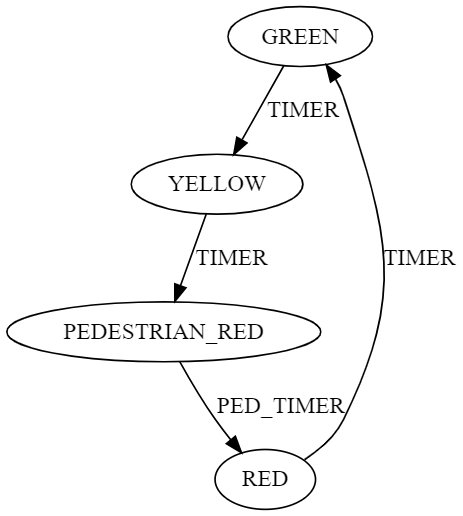This is a sample implementation of nested modal transducers from Chris's specification: https://github.com/cpressey/Nested-Modal-Transducers. This is not a complete 1:1 implementation of the transducer, as there is a difference in how we create outputs.
This repository attempts to replicate the traffic light machine as designed on the XState docs:
Since we don't have implicit side effects and nested labelling of hierarchical state machines, our implementation transition table must include a filler state PEDESTRIAN_RED to represent that the current parent state has its child state in transition. We need this because otherwise, a TIMER event could completely ignore our pedestrian light state machine and leave us in a logically invalid state. This also means that our starting state for the pedestrian light has to start at STOP if the traffic light starts at GREEN, which makes sense.
Transducers have access to a method called .ToDiGraph() to generate simple dot graphs. You can see an example of this in the *_test.go files inside the transducer folder:
Transducers have access to a method called .ToSQL(initialState state) to generate simple SQL state machines. You can see an example of this in the *_test.go files inside the transducer folder:
This idea came from Felix's post on state machines in PostgreSQL: https://felixge.de/2017/07/27/implementing-state-machines-in-postgresql/. After reading the article, I thought it would also be a nice QoL to include generation of SQL for ad-hoc audits:
CREATE OR REPLACE FUNCTION traffic_light_transition(state text, event text) RETURNS text LANGUAGE sql AS $$
SELECT
CASE state
WHEN 'RED' THEN CASE
EVENT
WHEN 'TIMER' THEN 'GREEN'
ELSE state
END
WHEN 'GREEN' THEN CASE
EVENT
WHEN 'TIMER' THEN 'YELLOW'
ELSE state
END
WHEN 'YELLOW' THEN CASE
EVENT
WHEN 'TIMER' THEN 'PEDESTRIAN_RED'
ELSE state
END
WHEN 'PEDESTRIAN_RED' THEN CASE
EVENT
WHEN 'PED_TIMER' THEN 'RED'
ELSE state
END
END
$$;
CREATE AGGREGATE traffic_light_fsm(text) (
SFUNC = traffic_light_transition,
STYPE = text,
INITCOND = 'GREEN'
);CREATE OR REPLACE FUNCTION pedestrian_light_transition(state text, event text) RETURNS text LANGUAGE sql AS $$
SELECT
CASE state
WHEN 'STOP' THEN CASE
EVENT
WHEN 'PED_TIMER' THEN 'WALK'
ELSE state
END
WHEN 'WALK' THEN CASE
EVENT
WHEN 'PED_TIMER' THEN 'WAIT'
ELSE state
END
WHEN 'WAIT' THEN CASE
EVENT
WHEN 'PED_TIMER' THEN 'STOP'
ELSE state
END
END
$$;
CREATE AGGREGATE pedestrian_light_fsm(text) (
SFUNC = pedestrian_light_transition,
STYPE = text,
INITCOND = 'STOP'
);Transducers have access to a method called .GetShortestPaths() to generate the shortest path between states. This path is generated with the Floyd-Warshall algorithm (for simplicity); these paths have not been deduped and truncated. You can see an example of this in the *_test.go files inside the transducer folder:
'RED' state
RED + TIMER -> GREEN
RED + TIMER -> GREEN
GREEN + TIMER -> YELLOW
RED + TIMER -> GREEN
GREEN + TIMER -> YELLOW
YELLOW + TIMER -> PEDESTRIAN_RED
'GREEN' state
GREEN + TIMER -> YELLOW
GREEN + TIMER -> YELLOW
YELLOW + TIMER -> PEDESTRIAN_RED
'YELLOW' state
YELLOW + TIMER -> PEDESTRIAN_RED
'STOP' state
STOP + PED_TIMER -> WALK
WALK + PED_TIMER -> WAIT
STOP + PED_TIMER -> WALK
'WALK' state
WALK + PED_TIMER -> WAIT
WALK + PED_TIMER -> WAIT
WAIT + PED_TIMER -> STOP
'WAIT' state
WAIT + PED_TIMER -> STOP
WAIT + PED_TIMER -> STOP
STOP + PED_TIMER -> WALK
We allow for output composition instead of coupling the outputs with the transition table. This means for cases (like the PEDESTRIAN_RED filler state), we can have logic that isn't trivial to generate SQL or dot graphs with without adding special cases for them. For instance, our nested machine must start at PEDESTRIAN_RED and STOP for the traffic light and pedestrian light machines respectively, if we wanted to make sure we generate the entire machine on the diagram/SQL. Not ideal, but at least we maintain strict consistency.
The initial design of the transducer only considered mirrored events/inputs across nested state machines such that it would encourage flat composition of outputs (without using native conditions inside the transition function). In addition, the orthoganal state machine story isn't as flushed out yet as our hierarchical example. Probably an upcoming TODO. The method to transitioning multiple state machines in parallel is quite trivial, but it isn't trivial to generate SQL or diagrams from.


